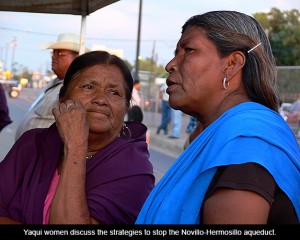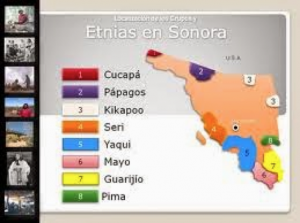 NOTE: This article is the fourth in a series by the CIP TransBorder Project that examines the water crisis on the U.S.-Mexico border.
NOTE: This article is the fourth in a series by the CIP TransBorder Project that examines the water crisis on the U.S.-Mexico border.
Hydraulic megaprojects will keep Sonora “competitive and sustainable” and create a “Nuevo Sonora,” declared Governor Guillermo Padrés at the start of his six-year term (2009-2015).
To advance this vision of a new era of water-based growth and development, Padrés established Sonora SI as a new semi-autonomous entity that would supervise some two-dozen water projects – with the clear priority being several dams, aqueducts, and irrigation projects.
Creating a new hydraulic society will be as easy as A, B, C, and D, states Sonora SI. That’s Agua, Bienestar, Crecimiento, and Desarrollo.
In this rosy scenario, new hydraulic infrastructure will ensure the delivery of water supplies (Agua), thus producing widespread well-being (Bienestar), economic growth (Crecimiento), and development (Desarrollo).[1]
Elsewhere, a rising number of local and national governments, together with international institutions, are shifting their focus away from megaprojects like dams. Instead they are turning their attention to resource-conservation and climate-adaptation strategies. As climate change advances and natural resources erode, around the world there is a rising understanding of the integral connections between healthy ecologies and healthy societies.
Yet by committing the state to a new array to water megaprojects, the Sonoran state government seems stuck in the old modernization paradigm. The narrow development and resource-use strategies of the past are not being reevaluated. In the New Sonora, social well-being is still regarded as being integrally closely to growth and resource extraction.
Especially in arid regions, citizens and governments are reevaluating the costs and benefits of hydraulic megaprojects. The value of existing water megaprojects are being reevaluated, while proposals for new hydraulic projects are increasingly undergoing cost-benefit assessments that take into account such factors as evaporation rates and the impact on river-based ecologies and cultures.
Sonora SI boasts that the state government is “reviving the hydraulic tradition of Mexico and the history of large waterworks projects in Sonora.” This “important hydraulic infrastructure sustains the life of the state and the development of its social, economic, and productive activities,” in the view of Sonora SI.
The working premise of Sonora SI for creating the state’s new hydraulic society is as simple as it is disconcerting: “Water will not be a limiting factor” not for “this generation or the coming ones.”
Although acknowledging the onset of climate change and the multitude of water crises facing the state, Sonora SI has concluded that a recommitment to water megaprojects is the state’s only viable option.[2]
Referring to its hydraulic projects, Sonora SI proclaims:
“In this way, water in Sonora will become the motor of our development. Water will make us much more competitive. Water will also ignite new industrial and commercial operations that will generate employment and opportunities.”
Whether this type of positive thinking about the future of water in the transborder region is visionary, as the Sonoran government claims, or fantastical is a question that is not getting much consideration in Sonora – aside from small circles of academics and environmentalists. Many Sonorenses are hoping that the government’s hydraulic interventions save them from a future of grim scenarios where desert cities and economies wither for lack of water.
The term sustainability does appear in the discourses of Sonora SI and Governor Padrés. But the term is never defined, and it is invariably connected to concepts such as competitiveness and growth. Whatever the rhetoric of Governor Padrés, Sonora SI launched– in close collaboration with Conagua (National Water Commission) and with other federal funding–large water projects without first consulting affected communities or seriously evaluating the likely adverse impacts on ecological systems and affected communities.
Neither the federal nor state government considered the possible adverse impacts on the indigenous communities — Yaquis, Mayos, and Guajiríos – of Sonora SI’s dams and aqueducts. There was no prior consultation, as mandated by national and international laws and conventions, with the indigenous communities whose land and water will be affected by these megaprojects.
The three water megaprojects prioritized by Governor Padrés — Independencia aqueduct, Revolución aqueduct, and Pilares dam – all deeply impact the ancestral and legally established rights of these indigenous peoples who have long depended on the flows of the Yaqui and Mayo Rivers.
 The modernization paradigm embodied in the water megaprojects of Sonora SI has also excluded any broader pre-project discussion of how the bienestar of healthy communities is closely related to the health of the environment.
The modernization paradigm embodied in the water megaprojects of Sonora SI has also excluded any broader pre-project discussion of how the bienestar of healthy communities is closely related to the health of the environment.
Scholars and environmentalists variously describe this connection between societies and the environment as biocultural diversity, biocultural evolution, cultures of habitat, or cultural sustainability.[3]
Water planners in Sonora and elsewhere in the transborder West would do well to consider the links between healthy societies, cultures, and environments. By doing so, governments would likely avoid igniting water wars. They might also help prevent more of type of socio-environmental disasters (often related to water use patterns and water shortages) that are mounting in Sonora– from the river valleys to the coastal plains, from the cities to endangered rural communities.
Scholars at the Colegio de Sonora examined the issue of water for indigenous communities in Sonora. Their report observed:
“One can observe the pattern of dislocation of indigenous people from their traditional homeland and from their natural resources, and that conflicts over water for subsistence are becoming increasingly severe – all of which exacerbates the vulnerability of these communities and the disintegration of their traditional biocultural frameworks.”[4]
“Orgullo de Sonora,” Gobierno de Sonora’s map of Native Indigenous Territories
Dimensions of Sonora’s New Hydraulic Society
There are five major thrusts of the water megaprojects of Sonora SI: Dams, aqueducts, water-treatment plants, improving potable water systems, and increasing reach of irrigation networks, according to the government.[5]
Aqueducts
* Providing new sources of water to urban centers in desert and in water-depleted deltas, including Hermosillo, Alamos, Huatabampo, Etchojoa, Navojoa, and Nacozari de García.
* Sonora SI is also overhauling the Yaqui-Guaymas aqueduct and pumps that supply it, even as agrochemical contamination and salinization of the soil worsen.
* Aqueducts will be built to conduct water from existing dams, notably from El Novillo on the Yaqui River and from Mocúzari on the Mayo River, the Independencia and Revolución aqueducts, respectively. According to Sonora SI’s vision, “Aqueducts are indispensable to distribute water equitably and responsibly among all Sonorans.”
Dams
* In some cases, new dams will be constructed, including the Bicentenario (Pilares) dam on the Mayo River and a few much-smaller dams and embalses including the Centenario dam near Narcozari de García and in the remote Las Trincheras area near Altar in the state’s northwestern territory (where there are new gold mining operations).
Water-Treatment of Waste and Residual Water
* Provide new sources of water or better quality water to Hermosillo, Guaymas, Nogales, Puerto Peñasco, and Navojoa by constructing water-treatment plants.
Drinking Water Infrastructure Projects
* Building a desalinization plant in the tourist town of San Carlos. check
* Overhauling water-delivery systems in Cananea and Puerto Peñasco.
Expanding and Improving Drylands Agriculture
* Assist the agricultural sector throughout western Sonora by improving irrigation canals (including in Yaqui and Mayo deltas, and outside Guaymas), by new dams that stop flooding in the monsoon season, and by expanding the “agricultural frontier” in Sonora.
* Providing water to all Sonorans in an “equitable and responsible” way will not involve any reduction of water to the agricultural sector – which consumes 92.3% of Sonora’s water.
Moreover, the hydraulic projects will “open new frontiers” to cultivation. In particular, the waterworks program will expand the irrigation districts that that currently draw on the Mayo and Fuerte Rivers in the southern corner of the state – bringing as much as 73,000 hectares into cultivation.
Photos by Tom Barry
FOOTNOTES:
[1] Sonora SI, “Acueducto Independencia,” Fondo de Operación de Obras, August 2012, at: http://www.sonorasi.gob.mx/eb/images/SONORA_SI_apuntes_31_08_2012.pdf
[2] Sonora SI, “Acueducto Independencia,” Fondo de Operación de Obras, August 2012, at: http://www.sonorasi.gob.mx/web/images/SONORA_SI_apuntes_31_08_2012.pdf
[3] Luque, Diana et al, “Pueblos indígenas de Sonora: el agua, ¿es de todos?” Región y Sociedad,, No.3, 2012. For an excellent treatment of this biocultural framework for sustainability (with field studies of Seris and Tohono O’, see: Gary Paul Nabhan, Cultures of Habitat: On Nature, Culture, and Story (Counterpoint, 1997). For a broader treatments, see, among others: E. Boege, El patrimonio biocultural de lost pueblos indígenas, Mexico, INAH, 2008; Luisa Maffi, On Biocultural Biodiversity: Linking Language, Knowledge and the Environment, Smithsonian Institute Press, 2001.
[4] Luque, Diana et al, “Pueblos indígenas de Sonora: el agua, ¿es de todos?” Región y Sociedad, No.3, 2012.
[5] Sonora SI, “Folleto Sonora SI,” at: http://issuu.com/gobiernosonora/docs/folleto-sonorasi?e=3267347/4339871#search
All articles in this 13-part series:
1. The Yaqui Water War
https://www.americas.org/archives/13463
2. Sonora and Arizona’s Uncertain Water Futures
https://www.americas.org/archives/13485
3. The Illusions of the New Sonora
https://www.americas.org/archives/13852
4. Sonora Launches Controversial Megaprojects in Response to Water Crisis
https://www.americas.org/archives/13854
5. Origins and Disappearance of the Yaqui River
https://www.americas.org/archives/13892
6. The Old and New Sonoras: The Context for Sonora’s Water Wars
https://www.americas.org/archives/14008
7. Making the Desert Bloom: The Rise of Sonora’s Hydraulic Society
https://www.americas.org/archives/14017
8. The Damming of the New Sonora
https://www.americas.org/archives/14025
9. Mining Boom in the Sierra Madre
https://www.americas.org/archives/14040
10. Mexico’s Three Mining Giants
https://www.americas.org/archives/14044
11. Mining Water in Sonora: Grupo México’s “Irregular” Water Permits in the Sonora, Yaqui, and San Pedro River Basins
https://www.americas.org/archives/13998
12. Making Mining Dreams Come True in Mexico
https://www.americas.org/archives/14055
13. Mining, Megaprojects, and Metrosexuals in Sonora



